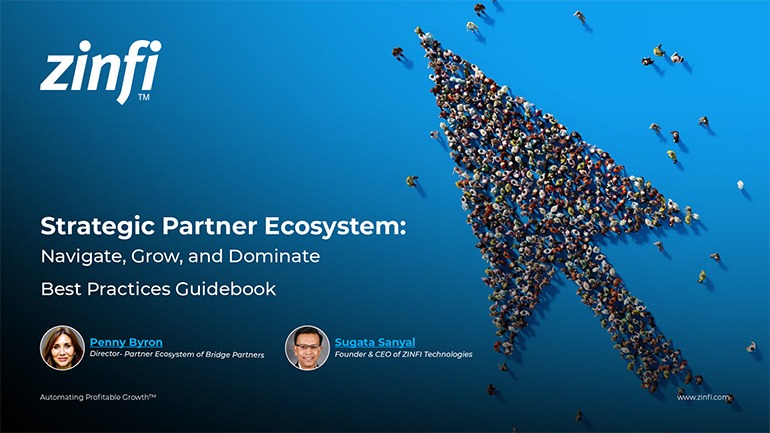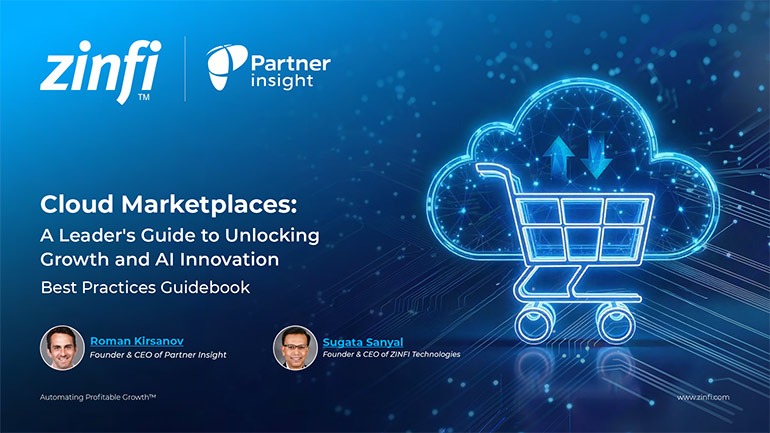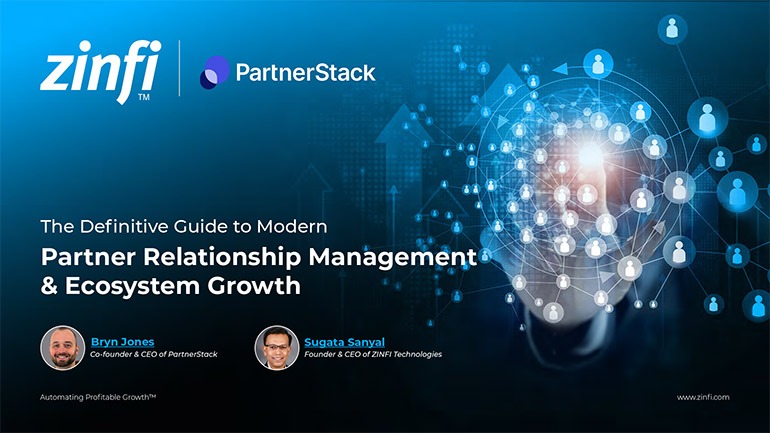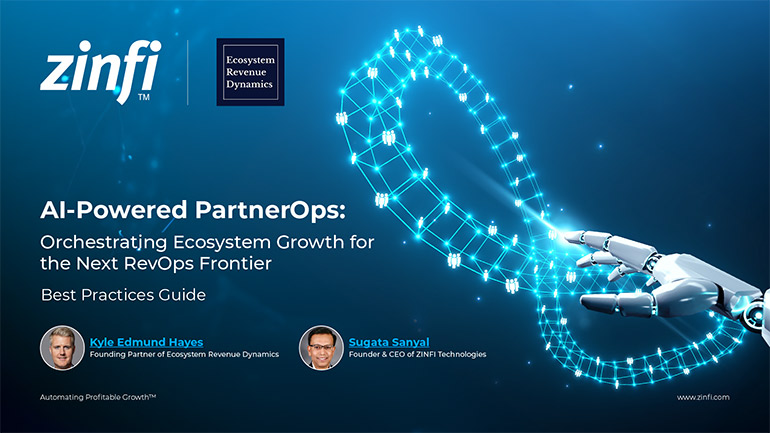Best Practices Articles

Building Bridges: Best Practices in Partner Relationship Management (PRM)
Table of Contents
- A Letter From the CEO
- Laying the Foundation: Understanding the Basics of Partner Relationship Management (PRM)
- Overview: Introduce the concept of PRM, its importance in today’s business landscape, and the potential benefits of effective PRM.
- Overview: Discuss the importance of selecting the right partners, the criteria to consider, and the potential pitfalls of poor partner selection.
- Overview: Delve into the importance of clear, consistent communication with partners and offer strategies and tools to facilitate this.
- Overview: Highlight the significance of providing partners with the necessary tools, resources, and training to succeed and represent your brand effectively.
- Overview: Discuss the importance of regular check-ins, feedback loops, and performance metrics to ensure the health and productivity of the partnership.
- Overview: Address common challenges and conflicts in partner relationships and provide strategies for resolution and prevention.
- Overview: Look at the future trends in PRM, the importance of adaptability, and how to ensure long-term growth and success in partner relationships.
- Overview: With a myriad of options available, it’s essential to pinpoint a platform that boasts enterprise-level reliability, user-friendly interfaces, cost-effectiveness, and the flexibility to evolve from basic setups to more complex configurations as your needs grow.
A letter from the CEO
Dear Readers,
Welcome to our comprehensive guide on best practices for partner relationship management (PRM). As the CEO of ZINFI, I’ve witnessed firsthand the transformative power of effective PRM in shaping the trajectory of businesses. In today’s rapidly evolving business landscape, fostering and nurturing partner relationships is not just a strategy—it’s a necessity.
Our guide begins by laying the foundation with an in-depth look into the essence of PRM, highlighting its significance in today’s market. As we move forward, we delve into the critical aspects of choosing the right partners, emphasizing the importance of alignment and the potential repercussions of misaligned partnerships.
Communication, as we all know, is the lifeblood of any relationship. Our third chapter underscores the pivotal role of clear and consistent communication in partner engagement, supplemented by tools and strategies that have proven effective in our experience at ZINFI.
But communication alone isn’t enough. Equipping our partners with the right tools, resources, and training is paramount, ensuring they represent our brand effectively and thrive in their endeavors. This sentiment is echoed in our discussions on training and enablement.
Monitoring and feedback serve as the pulse check of any partnership. Regular check-ins, constructive feedback, and performance metrics are instrumental in gauging the health of our collaborations. And, as with any relationship, challenges are inevitable. Our guide offers invaluable insights into conflict resolution, ensuring that challenges are addressed and prevented.
Adaptability is a key concept in a world where change is the only constant. Our final article paints a picture of the future of partner relationship management, emphasizing the importance of evolving together and setting the stage for sustained growth.
Last but certainly not least, choosing the right PRM provider is paramount. With a plethora of options available, it’s vital to select a platform that’s robust, user-friendly, and scalable. For a provider that checks all these boxes and more, I’d recommend exploring our offerings at www.zinfi.com.
This guide is more than just a collection of best practices—it’s a roadmap to forging more robust, fruitful partner relationships. I hope you find it as enlightening as we did in creating it. Here’s to building and nurturing successful partnerships!
Warm regards,
Sugata Sanyal
CEO, ZINFI
Laying the Foundation: Understanding the Basics of Partner Relationship Management (PRM)
In today’s interconnected business world, the essence of collaboration and partnership has never been more vital. The concept of partner relationship management (PRM) has emerged as a cornerstone for businesses aiming to nurture and optimize these partnerships. But what is PRM, and why has it become such a pivotal aspect of modern business operations? Let’s take a closer look at the intricacies of PRM, its significance, and the manifold benefits it offers.
Defining Partner Relationship Management (PRM)
Partner relationship management, commonly referred to as PRM, is a blend of strategies, methodologies, and tools businesses employ to manage and enhance their relationships with external business partners. These partners can encompass a broad spectrum, from distributors, resellers and affiliates to collaborators who sell, promote, or enhance a company’s offerings.
The overarching objective of PRM is to ensure a harmonious alignment between a company and its partners, fostering a symbiotic relationship that promotes mutual growth, profitability, and success. By leveraging a sophisticated partner relationship management platform or PRM tool, businesses can automate and streamline various partner-centric tasks, from training onboarding to detailed performance analytics.
The Growing Importance of PRM in the Contemporary Business Landscape
- Global Reach and Local Expertise: As businesses ambitiously venture into international markets, they frequently lean on local partners to gain a foothold and understand the nuances of these new territories. Partner relationship management becomes the bridge, ensuring these relationships are cultivated, managed, and optimized for mutual success.
- Navigating the Digital Maze: The digital revolution has ushered in a complex business ecosystem. With multiple touchpoints and channels, managing partner relationships can become daunting. Robust PRM software becomes indispensable, offering clarity, coherence, and a structured approach to navigating this digital maze.
- Achieving a Competitive Edge: Every advantage counts in the cutthroat business world. Effective partner relationship management can set companies apart. Those adept at managing their partner relationships are often better positioned to adapt to market fluctuations, seize emerging opportunities, and mitigate potential risks.
Unraveling the Multifaceted Benefits of Partner Relationship Management
- Strengthened Collaboration: State-of-the-art PRM software can catalyze enhanced communication and collaboration. By providing a centralized platform, it ensures alignment, coherence, and synergy among all stakeholders.
- Boosting Sales and Revenue Streams: Effective partner relationship management can be the linchpin for increased sales. When partners are equipped, empowered, and motivated, they become formidable sales allies, driving revenue and expanding market reach.
- Operational Efficiency and Cost Reduction: Automation is at the heart of modern PRM tools. Businesses can achieve operational efficiency by automating repetitive and time-consuming tasks, significantly saving costs.
- Cultivating Partner Loyalty: Loyalty is the bedrock of any lasting relationship. When partners perceive that they are valued, supported, and integral to mutual success, they exhibit increased loyalty, commitment, and enthusiasm.
- Informed, Data-Driven Strategies: Modern PRM software is not just a management tool; it’s an analytical powerhouse. With real-time insights, trend analysis, and performance metrics, businesses can make informed, strategic decisions, optimizing their partner strategies.
The Quest for the Ideal PRM Tool
With the undeniable advantages of PRM, the quest for the perfect partner relationship management tool or software becomes paramount. Here are some considerations:
- Intuitive Usability: The PRM tool should be designed with the user in mind. A steep learning curve can be counterproductive. Opt for a tool that’s intuitive, user-friendly, and easy to navigate.
- Seamless Integration: In today’s tech-driven business world, integration is critical. Your chosen PRM software should seamlessly meld with other systems, ensuring a cohesive tech ecosystem.
- Future-Proof Scalability: Businesses evolve, and so do their needs. Ensure that your partner relationship management tool is scalable and capable of adapting and growing with your business’s ever-changing requirements.
- Unwavering Support and Comprehensive Training: The journey with a PRM tool doesn’t end with its purchase. Look for providers that offer robust support, regular updates, and comprehensive training sessions.
PRM is not merely a contemporary business acronym; it’s a transformative approach to business that can catalyze exponential growth. By grasping the nuances of partner relationship management and investing judiciously in a top-tier PRM tool, businesses can cultivate and nurture robust, fruitful, and enduring relationships with their partners. In today’s dynamic business environment, and competitive realm, mastering partner relationship management isn’t just a luxury—it’s an imperative.

Choosing the Right Partners: Criteria and Considerations
In today’s interconnected business world, the importance of selecting the right partners cannot be overstated. Whether you’re a startup looking to scale or an established enterprise aiming to expand your reach, the partners you choose can make or break your success. Partner relationship management (PRM) is a framework that helps businesses select partners who are aligned with their goals and values. This chapter explores the significance of choosing the right partners, the most important criteria to consider, and the potential pitfalls of poor partner selection.
The Importance of Selecting the Right Partners
- Strategic Alignment: The right partners can help your business achieve its objectives. Whether you are entering a new market, launching a product, or expanding your customer base, having partners that align with your strategy can accelerate your growth.
- Operational Efficiency: Collaborating with partners who understand your operational processes and systems can increase efficiency. This is where partner relationship management becomes especially helpful, ensuring seamless integration and collaboration.
- Brand Reputation: Your partners are an extension of your brand. Associating with reputable partners enhances your brand’s image, while poor choices can tarnish it.
Criteria to Consider in Partner Selection
- Alignment with Business Goals: Before entering a partnership, ensure the potential partner’s goals align with yours. This can be assessed by assessing their mission, vision, and past performance.
- Financial Stability: A partner’s financial health is crucial. A financially unstable partner can lead to disruptions, adversely affecting your operations.
- Cultural Fit: A potential partner’s values, work ethic, and organizational culture should resonate with yours. A cultural mismatch can lead to conflicts and inefficiencies.
- Technical Compatibility: Partners must have compatible systems and technologies, especially in tech-driven industries. This ensures smooth operations and reduces the chances of technical glitches.
- Reputation and Track Record: Research the potential partner’s reputation in the market. A good track record is often an indicator of reliability and trustworthiness.
- Flexibility and Adaptability: The business environment is dynamic. Partners adapting to changing circumstances are more valuable in the long run.
Pitfalls of Poor Partner Selection
- Operational Disruptions: A misaligned partner can lead to operational hiccups, affecting service delivery and customer satisfaction.
- Financial Losses: If a partner faces financial difficulties or goes bankrupt, it can lead to significant financial losses for your own business.
- Reputational Damage: Associating with a partner who engages in unethical practices can harm your brand’s reputation and cause you to lose the trust of customers and stakeholders.
- Resource Drain: A non-performing partner can drain your resources in time and money. Instead of focusing on growth, you might find yourself managing conflicts and issues.
- Missed Opportunities: A poor-performing partner might need more expertise or resources to tap into new opportunities, leading to potential revenue losses.
Leveraging Partner Relationship Management (PRM) Software to Select and Retain the Right Partners
Partner relationship management is a strategic approach to managing an organization’s partner interaction. By leveraging PRM tools and strategies, businesses can:
- Streamline Partner Onboarding: PRM systems can automate and simplify onboarding, ensuring that only suitable partners are onboarded.
- Monitor Partner Performance: With PRM, businesses can track and evaluate the performance of their partners to help them meet established standards.
- Facilitate Communication: PRM tools provide a platform for seamless communication between businesses and their partners so that any issues that arise are addressed promptly.
- Enhance Collaboration: PRM systems offer tools for collaboration to make it easy for partners to work together toward achieving common goals.
In conclusion, choosing the right partners is crucial for the success of any business. Businesses can make informed decisions by considering the outlined criteria and being aware of the potential pitfalls. Furthermore, leveraging partner relationship management can add depth to the partner selection process, ensuring businesses collaborate with partners aligning with their goals and values.

Communication Is Key: Effective Strategies for Partner Engagement
In the intricate web of business relationships, effective communication emerges as a cornerstone for success. Particularly in partner relationship management (PRM), the nuances of clear and consistent communication can be the difference between a flourishing partnership and one that’s on shaky ground. As businesses venture into global markets and establish collaborative relationships with many partners, the imperative for robust communication strategies becomes even more pronounced. This overview explores the essential factors in maintaining transparent communication channels with partners and offers a variety of methods and tools to enhance communication with partners.
Why Clear, Consistent Communication Matters Is Important for Effective Partner Relationship Management
- Building Trust: At the heart of any enduring partnership lies trust. Regular, transparent communication nurtures this trust, ensuring all parties understand mutual expectations and objectives. When partners feel in the loop, they are likelier to invest their best efforts in the collaboration.
- Aligning Goals: With the involvement of multiple stakeholders, there’s a potential risk of misaligned objectives. Through consistent communication, businesses can make sure that all partners remain focused on a unified vision, maximizing the chances of achieving shared goals.
- Facilitating Collaboration: Effective communication acts as the lubricant for seamless collaboration, helping partners efficiently leverage each other’s strengths, expertise, and resources to achieve shared milestones.
- Resolving Conflicts: Disagreements and conflicts are natural in any partnership. However, with open communication channels, these issues can be addressed directly and resolved promptly, preventing minor misunderstandings from snowballing into major disputes.
Strategies for Effective Partner Communication
- Establish Clear Communication Protocols: It’s crucial to delineate clear communication guidelines. This involves specifying what, when, and how interactions take place. By developing a structured communication protocol, businesses can ensure that vital information is consistently shared and nothing is overlooked.
- Regular Check-ins: Consistent interactions form the backbone of effective communication. This may take the form of weekly catch-up calls, monthly progress meetings, or quarterly strategy reviews. These scheduled interactions provide a platform for businesses and their partners to discuss achievements, address potential challenges before they become serious problems, and recalibrate objectives as needed.
- Leverage Technology: he digital revolution has ushered in many tools designed to facilitate communication, ranging from sophisticated video conferencing tools like Zoom to collaboration platforms such as Slack. Technology can seamlessly bridge potential communication gaps, particularly when partners are spread across different geographies.
- Feedback Mechanisms: It is important for businesses to offer dedicated channels for partners to voice their feedback. This may involve detailed surveys, feedback forms or open discussion forums. Actively seeking and valuing partner feedback can significantly bolster the relationship and cultivate trust and loyalty.
- Training and Onboarding: Comprehensive training sessions are a pivotal part of nurturing relationships with your partners. When your partners are well-acquainted with your products, services, and operational processes, the chances of miscommunication and misunderstandings are greatly reduced.
Technology Tools to Augment Partner Communication
- Partner Portals: PRM platforms like ZINFI’s offer state-of-the-art, mobile-responsive partner portals. These portals serve as a one-stop shop for partners to navigate through channel programs, access relevant content, and engage with tailored campaigns. By centralizing communication, partner portals ensure that partners are always equipped with the information they need to succeed.
- Unified Partner Management Tools: These tools are a boon for businesses that manage diverse content, campaigns, and applications across a broad spectrum of user groups, partner types, and regions. They not only streamline communication but also ensure that content is customized, catering to the unique needs of different partners.
- Collaboration Platforms: Real-time communication and collaboration tools like Microsoft Teams or Trello can foster community and teamwork among partners, making them feel more integrated and involved.
- Content Management Systems: Keeping partners updated with the latest information is paramount. PRM platforms that allow dynamic content updating and distribution ensure that partners are always in sync with the latest developments. These systems also enable businesses to promote and track the utilization of channel programs, significantly enhancing partner engagement and motivation.
The familiar adage, “Communication is the key to success,” is especially relevant to partner relationship management. Businesses can cultivate robust, mutually beneficial partnerships by prioritizing clear, consistent communication and arming themselves with the right strategies and tools. Effective communication will undeniably become even more central as the business landscape evolves and collaborations become more complex. When businesses acknowledge the significance of effective communication and strategically invest in communication tools and practices, they lay a solid foundation for enduring partnership success.

Training and Enablement: Empowering Partners for Success
In a rapidly evolving business world, partnerships are the key to driving growth and expanding market reach. However, the success of these partnerships hinges on more than just a signed agreement. Partners must be empowered with the right tools, resources and training to represent your brand effectively to achieve mutually beneficial results. This is where the essence of partner relationship management (PRM) lies. This chapter takes a close look at training and enablement strategies, explaining how businesses can equip their partners for success.
The Benefits of Partner Training and Enablement
- Brand Consistency: Partners act as an extension of your brand. Proper training ensures that they represent your brand consistently, maintaining its integrity and reputation in the market.
- Operational Excellence: By equipping partners with the necessary tools and resources, businesses can ensure smooth operations, leading to increased customer satisfaction and loyalty.
- Increased Sales and Revenue: Well-trained partners are more effective in selling products or services, and contribute to increased sales and revenue for both the business and the partner.
- Strengthened Partnership: Training and enablement programs foster a sense of belonging and commitment among partners. This strengthens the bond between businesses and their partners and ensures that effective collaboration will endure over the long term.
Strategies for Effective Partner Training and Enablement
- Comprehensive Onboarding: The onboarding process is the first step in partner training. It should provide partners with an overview of the company’s products, services, values, and expectations. This sets the tone for the entire partnership.
- Regular Training Sessions: The business landscape is ever-evolving. Regular training sessions ensure partners keep current with the latest product features, market trends, and sales techniques.
- Access to Resources: Partners should have easy access to resources like product manuals, sales scripts, marketing collateral, and more. These resources provide information that is crucial to their day-to-day activities and ensure they are equipped to handle customer queries effectively.
- Feedback and Evaluation: Businesses should regularly evaluate partner performance and provide constructive feedback. This helps them identify areas that require improvement and tailor training programs accordingly.
- Leverage Technology: Use appropriate technology to facilitate training. Platforms like ZINFI offer mobile-responsive partner portals that partners can navigate on their own to access content, campaigns and partner programs. Such platforms ensure that partners always have the latest information at their fingertips whenever they need it.
Tools and Platforms for Partner Enablement
- Unified Partner Management Tools: These tools allow businesses to set up and manage content, campaigns, and applications tailored to various user groups, partner types, and regions. They ensure that partners always have access to relevant, up-to-date information.
- Mobile-Responsive Partner Portals: A dedicated portal, like the one offered by ZINFI, ensures that partners can quickly find the content and programs they are eligible for, wherever they are and whenever they like. Such outlets are equipped with user-friendly DIY tools, making it easy for partners to access and utilize resources.
- Content Management Systems: Businesses that can dynamically update, manage, and distribute content to partners ensure their partner network is always equipped with the latest information. Content management tools also allow businesses to promote and track the utilization of channel programs and access data-based insights into partner engagement and effectiveness.
- Interactive Training Platforms: Tools like webinars, video tutorials, and e-learning modules can make training more interactive and engaging, leading to better retention and understanding.
In partner relationship management, training and enablement are not mere buzzwords but the bedrock of successful partnerships. By investing in comprehensive training programs and providing partners with the tools and resources they need, businesses can ensure their partners are not just vendors but valuable brand ambassadors. As the global business ecosystem becomes increasingly interconnected, the role of partners becomes even more crucial. To pave the way for mutual growth and long-term success, businesses must recognize the significance of training and enablement and make strategic investments in programs and tools that help partners thrive.

Monitoring and Feedback: The Pulse of Partnership Health
In the intricate dance of business partnerships, the rhythm is set by agreements and collaborations and the continuous monitoring and feedback underpinning them. Just as a doctor checks a patient’s pulse to gauge their health, businesses must regularly assess the vitality of their partnerships. Partner relationship management (PRM) emphasizes regular check-ins, feedback loops, and performance metrics as vital indicators of partnership health. This chapter explores the importance of these elements and illustrates how businesses can leverage PRM platforms like ZINFI’s to ensure the productivity and health of partnerships.
The Benefits of Monitoring and Feedback in Partner Relationship Management
- Ensuring Alignment: Regular check-ins and feedback help businesses and their partners remain aligned in their goals, strategies and expectations. This alignment is crucial for the long-term success of partnerships.
- Identifying Areas of Improvement: Continuous monitoring allows businesses to identify areas where partners may need additional support, training or resources so they can proactively address potential issues.
- Building Trust: Open feedback loops foster transparency and trust. When partners feel their opinions are valued and their successes are acknowledged, it strengthens the bond of collaboration.
- Driving Performance: By establishing and monitoring key performance metrics, businesses can motivate partners to do their best work, ensuring mutual growth and success.
Strategies for Effective Monitoring and Feedback
- Scheduled Check-ins: Regularly scheduled check-ins, whether weekly, monthly, or quarterly, provide a structured platform for discussing progress, addressing concerns, and recalibrating strategies.
- Feedback Surveys: Periodic feedback surveys can offer valuable insights into a partner’s experience, challenges, and suggestions. These surveys can be tailored to gather specific information and generate actionable insights.
- Performance Dashboards: Performance dashboards give businesses a real-time view of partner achievements, challenges, and contributions. Platforms like ZINFI offer tools that both promote and track the utilization of channel programs and provide organizations with a comprehensive view of partner engagement and performance.
- Open Communication Channels: Encourage partners to openly voice their concerns, suggestions, and feedback. An open-door policy can foster a culture of transparency and mutual respect, and it can also lead to important insights.
- Training and Resource Updates: Continuously update training materials and resources based on feedback and monitoring. This ensures that partners always have the latest information and tools.
Leveraging Technology for Partnership Health
- Unified Partner Management Tools: PRM platforms like ZINFI’s offer a suite of Unified Partner Management tools that allow businesses to manage content, campaigns, and applications tailored for various partner types and regions. These integrated tools ensure that partners always have access to relevant, up-to-date information that keeps them engaged and helps them achieve better results.
- Mobile-Responsive Partner Portals: Using a dedicated partner portal, partners can quickly navigate through channel programs and access relevant content. Such portals, designed with user-friendly DIY tools, make it easy for partners to stay updated and engaged.
- Automated Feedback Systems: Using PRM tools, businesses should deploy automated systems that gather feedback regularly or after specific milestones. This ensures consistent feedback collection and analysis.
- Data Analytics: Data analytics are essential to assessing partnership health. By analyzing data trends, businesses can gain insights into partner performance, market trends, and potential areas of improvement.
Monitoring and feedback are the lifeblood that sustains and nourishes partnerships in the vast and complex landscape of partner relationship management (PRM). Businesses that prioritize monitoring and feedback are much more likely to sustain healthy, productive, and aligned partnerships based on mutual goals. As partnerships evolve and the business environment becomes increasingly dynamic, the role of regular check-ins, feedback loops, and performance metrics will only grow in importance. By recognizing the importance of these efforts and leveraging the right tools and strategies, businesses can cultivate partnerships that thrive and drive mutual success.

Conflict Resolution: Navigating Challenges in Partner Relationships
Conflicts and challenges are inevitable in the intricate tapestry of business partnerships. As businesses collaborate to achieve mutual goals, differences in perspectives, expectations, and strategies can lead to friction. However, the key to a successful partnership isn’t the absence of conflicts but the ability to navigate and resolve them effectively. Partner relationship management (PRM) emphasizes the importance of conflict resolution as a critical component of maintaining healthy, productive partnerships. Drawing upon insights from our extensive experience with advanced PRM platforms like ZINFI’s, this chapter addresses common challenges in partner relationships and offers strategies for resolution and prevention.
Understanding the Roots of Conflicts in Partner Relationships
- Misaligned Goals: One of the most common challenges in partnerships is the misalignment of goals. Partners’ different objectives or priorities can lead to misunderstandings and disagreements.
- Differing Operational Processes: Variations among partners’ operational processes and systems can result in inefficiencies and friction.
- Communication Breakdown: Ineffective communication or lack of transparency can lead to misconceptions, creating and sometimes escalating conflicts.
- Resource Limitations: Disputes can arise when there are limitations in resources such as finances, manpower or tools.
- Cultural and Organizational Differences: Partnerships often span multiple regions and cultures. Differences in work ethics, values, and organizational cultures can sometimes lead to conflicts and challenges.
Strategies for Effective Conflict Resolution
- Open Dialogue: Encourage open communication across the partner ecosystem. Addressing issues head-on through dialogue can lead to mutual understanding and resolution.
- Leverage Technology: Platforms like ZINFI offer Unified Partner Management (UPM) tools that allow businesses to manage content, campaigns, and applications customized for various partner types. Such tools can streamline operations, reducing the likelihood of operational conflicts.
- Regular Check-ins: Scheduled check-ins give businesses and their partners an opportunity to discuss progress, address concerns, and realign goals, ensuring that potential issues are addressed proactively.
- Training and Onboarding: Comprehensive training sessions can equip partners with the knowledge necessary for success and reduce the chances of miscommunication. Platforms like ZINFI’s UPM offer feature mobile-responsive partner portals that partners can navigate to quickly access relevant content and keep up to date.
- Feedback Mechanisms: Create avenues for partners to provide regular feedback. Listening to partners and acting on their concerns can prevent minor issues from escalating.
- Third-party Mediation: In cases where conflicts are challenging to resolve internally, consider third-party mediation. Neutral parties can provide objective insights and facilitate resolution.
Preventive Measures for Conflict Minimization
- Clear Agreements: Ensure that partnership agreements are explicit, detailing roles, responsibilities and expectations. This clarity can prevent many potential conflicts.
- Cultural Sensitization: Invest in cultural sensitization programs if partnerships span different cultures. Understanding and respecting cultural differences can prevent misunderstandings.
- Resource Allocation: Clearly define resource allocation from the outset. Ensure that partners are aware of the resources available to them to reduce the likelihood of disputes related to limitations.
- Regular Reviews: Conduct regular partnership reviews to assess the relationship’s health. Addressing potential challenges early on can prevent them from becoming major conflicts.
- Collaborative Decision-Making: Involve partners in decision-making processes, especially when a decision impacts them directly. This inclusivity can foster a sense of belonging and reduce the risk of disagreements.
While conflicts in partner relationships are natural, they don’t have to spell doom for the partnership. With the right strategies, businesses can navigate challenges effectively, turning potential pitfalls into opportunities for growth and collaboration. A structured approach to partner relationship management that emphasizes conflict resolution—with the help of robust partner relationship management technology—can provide a roadmap for businesses seeking to cultivate and maintain healthy, productive partnerships. Companies that understand the roots of conflicts, implement effective resolution strategies, and take preventive measures can ensure that their partnerships thrive and remain mutually beneficial.

Evolving Together: The Future of Partner Relationship Management and Sustained Growth
In the ever-evolving business landscape, adaptability is not just a virtue but a necessity. As companies expand and diversify, the role of partners becomes increasingly pivotal. Partner relationship management (PRM) stands at the forefront of this evolution, ensuring businesses and their partners grow in tandem, adapting to changes and capitalizing on opportunities. With platforms like ZINFI offering innovative solutions, the future of partner relationship management looks promising. This chapter explores emerging trends in PRM, underscores the importance of adaptability in the face of those trends, and provides insights for ensuring long-term growth and success in partner relationships.
Future Trends in Partner Relationship Management
- Digital Transformation: The digital revolution is reshaping partner relationship management. Mobile-responsive partner portals, like those offered by ZINFI, are becoming the norm, ensuring that partners can seamlessly navigate channel programs and easily access relevant content and campaigns from a computer or phone.
- Data-Driven Decisions: The future of partner relationship management (PRM) will rely heavily on data analytics. Businesses will increasingly leverage data to assess partnership health, track performance metrics, and make informed decisions.
- Personalized Partner Experiences: With the availability of advanced Unified Partner Management tools, businesses can customize content, campaigns, and applications for various partner types, regions, and languages, ensuring a personalized partner experience.
- Increased Automation: Automation will play a significant role in streamlining operations, from onboarding partners to tracking the utilization of channel programs.
- Collaborative Ecosystems: Partner relationship management will evolve to foster more collaborative ecosystems where businesses, partners, and competitors combine forces to offer comprehensive, holistic solutions to customers.
The Imperative of Adaptability in Partner Relationship Management (PRM)
- Navigating Market Changes: The business environment is dynamic. An adaptable partner relationship management strategy ensures businesses and their partners can swiftly navigate market changes, seizing new opportunities and mitigating challenges.
- Meeting Diverse Partner Needs: As businesses collaborate with a diverse set of partners, they must remain adaptable in order to address the unique needs, expectations, and challenges of each partner.
- Incorporating Technological Advancements: Like the business landscape, the tech landscape is continuously evolving. An adaptable partner relationship management approach ensures businesses can quickly and seamlessly integrate new technologies, tools and platforms as needed to enhance and sustain healthy partner relationships.
Strategies for Ensuring Long-Term Growth in Partner Relationships
- Continuous Learning: Invest in regular training sessions, ensuring that partners are updated with the latest product features, market trends, and sales techniques.
- Feedback Loops: Construct avenues for partners to provide feedback. Actively seeking and valuing partner feedback can bolster the relationship and drive growth.
- Resource Allocation: Ensure partners have access to the necessary financial resources, manpower, tools, and training to stay relevant in the market and succeed. Adequate resource allocation can drive partner performance and, in turn, business growth.
- Regular Reviews: Conduct periodic partnership reviews to assess the relationship’s health, address potential challenges, and recalibrate strategies for mutual growth.
- Leverage Technology: Platforms like ZINFI’s Partner Relationship Management offering provide powerful tools to enhance partner engagement, streamline operations and drive growth. By leveraging such platforms, businesses can position themselves to respond rapidly to a changing business environment and ensure sustained growth in partner relationships.
“Change is the only constant,” according to an old adage. This couldn't be more true in the realm of partner relationship management. The landscape of partner relationship management is poised for evolution, with technological advancements, data-driven strategies, and personalized partner experiences shaping its trajectory. The secret to keeping pace with this evolution lies in the principle of adaptability. Businesses that embrace change and continuous learning, while leveraging the right tools and strategies, will be able to evolve together with their partners, driving mutual growth and long-term success. As we look ahead, the future of partner relationship management promises exciting opportunities, and businesses that embrace adaptation, innovation, and collaboration will be the ones leading the charge.

Navigating Partner Relationship Management Solutions: Identifying Your Ideal Provider
In today’s interconnected business landscape, partner relationship management (PRM) has emerged as a linchpin for fostering and nurturing successful partnerships. With many PRM solutions flooding the market, businesses are often faced with the daunting task of selecting the ideal provider. The right PRM platform can be the difference between a thriving partnership ecosystem and a disjointed, inefficient one. This chapter is designed to guide businesses seeking to identify a partner relationship management provider that offers enterprise-level reliability, a user-friendly interface, cost-effectiveness, and the flexibility to evolve as market conditions change.
The Most Important Benefits of a Robust PRM Solution
A PRM solution acts as the central nervous system of partner relationships, streamlining operations, enhancing communication, and driving mutual growth. The right solution can:
- Boost Operational Efficiency: Partner relationship management solutions can significantly enhance operational efficiency by automating tasks and centralizing information.
- Foster Collaboration: A user-friendly PRM platform facilitates seamless collaboration between businesses and their partners.
- Drive Growth: With the right tools and resources, partners can effectively market and sell products, driving mutual growth.
Key Considerations When Identifying Your Ideal Partner Relationship Management Provider
- Enterprise-Level Reliability: In business, downtime can lead to significant losses. Your partner relationship management provider should have a proven track record of reliability, offering consistent uptime and robust security measures.
- User-Friendly Interfaces: The effectiveness of a partner relationship management solution is often determined by its usability. Platforms like ZINFI's offer a mobile-responsive partner portal that partners can easily navigate and adapt for their unique purposes. User-friendly DIY tools ensure businesses can seamlessly set up and manage content, campaigns, and applications.
- Total Cost of Ownership: While investing in a robust PRM solution is essential, ensuring the platform offers value for money is equally crucial. Evaluate the provider’s features, tools, and resources against the cost to ensure cost-effectiveness.
- Flexibility and Scalability: As businesses grow, their needs evolve. The ideal partner relationship management provider should offer modular solutions that can evolve from basic setups to more complex configurations. Whether you need to dynamically update content, manage diverse campaigns, or promote channel programs, the platform you select should offer the flexibility to cater to growing business needs.
- Comprehensive Support: A dedicated support team that offers timely assistance, training, and guidance can significantly enhance the partner relationship management experience.
Top 10 Partner Relationship Management Vendors to Consider for Your Business
For a comprehensive review and comparison of these vendors, you can refer to G2 Partner Management Software.
- ZINFI: A leader in the partner relationship management (PRM) space, ZINFI offers a comprehensive suite of tools tailored to diverse partner types and regions. Their platform emphasizes mobile-responsive content, dynamic content management, and channel program utilization, ensuring partners always have the latest information at their fingertips.
- Impartner: Known for its robust PRM solutions, Impartner aids businesses in accelerating partner revenue and optimizing partner engagement. Their platform is user-friendly and offers a range of customizable features.
- Allbound: This partner relationship management platform focuses on driving partner success through collaborative selling. It offers tools for content sharing, joint marketing, and real-time collaboration, ensuring partners are always aligned.
- PartnerStack: This platform is designed to help companies leverage partnerships to grow revenue, increase distribution, and go to market more quickly and efficiently.
- Magentrix: Specializing in partner and customer portals, Magentrix offers solutions that enhance collaboration, streamline communication, and drive partner success with intuitive, cloud-powered tools.
- Mindmatrix: Offering both partner relationship management and channel marketing automation, Mindmatrix provides partners with the tools they need to effectively market, sell, and boost their productivity.
- Channeltivity: Focusing on ease of use, Channeltivity offers a PRM solution that helps businesses manage, support, and enable their channel partners with intuitive tools.
- Webinfinity: This platform emphasizes engagement automation, ensuring partners remain engaged, informed, and productive. Their solution is known for its flexibility and adaptability.
- Kiflo: This PRM solution streamlines partner recruitment, onboarding, and management. The user-friendly platform provides a range of tools to boost partner success.
- Affise: While primarily known as a performance marketing platform, Affise offers tools that can be leveraged for partner management, ensuring that partners have the resources they need to succeed.
By considering the offerings and specialties of each of these vendors, businesses can make an informed decision about which PRM solution aligns best with their needs and objectives. Because partnerships are now playing a more pivotal role than ever in business growth, investing in the right PRM platform is crucial.
Navigating a myriad of PRM solutions can be challenging. However, businesses can pinpoint their ideal provider by focusing on critical considerations like reliability, user-friendliness, cost-effectiveness, and flexibility. Advanced platforms like ZINFI’s emphasize the importance of adaptability, comprehensive support, and dynamic content management. As businesses continue to expand and foster partnerships, the role of a robust partner relationship management solution becomes even more pivotal. By investing in the right platform, companies can build long-term partnerships that drive mutual growth and success.
For more information, please check this article.


Best Practices Guidebook
 The Partner-Led Digital and AI Transformation Best Practices
The Partner-Led Digital and AI Transformation Best PracticesDownload for FREE
 Startup Talent Recruitment: Hiring Missionaries, Not Mercenaries
Startup Talent Recruitment: Hiring Missionaries, Not MercenariesDownload for FREE
 The Future of Partner Relationship Management with AI in Partnerships
The Future of Partner Relationship Management with AI in PartnershipsDownload for FREE
 Cybersecurity for the 99%: Strategies from the Frontline
Cybersecurity for the 99%: Strategies from the FrontlineDownload for FREE
 Mastering Partner Relationships: A Strategic Approach to Business Growth
Mastering Partner Relationships: A Strategic Approach to Business GrowthDownload for FREE
 The Smart Manufacturing Playbook: Industry 4.0 Transformation
The Smart Manufacturing Playbook: Industry 4.0 TransformationDownload for FREE
 Mastering Partner Relationship Management: Keys to SaaS Channel Success
Mastering Partner Relationship Management: Keys to SaaS Channel SuccessDownload for FREE
 Navigating the AI Revolution: Guide for Partners in the Microsoft Ecosystem
Navigating the AI Revolution: Guide for Partners in the Microsoft EcosystemDownload for FREE
 Mastering the Modern Buyers Journey: Sales Leader’s Guide to AI & Engagement
Mastering the Modern Buyers Journey: Sales Leader’s Guide to AI & EngagementDownload for FREE
 Hybrid Cloud and Edge AI Computing Impacting the Future of PRM
Hybrid Cloud and Edge AI Computing Impacting the Future of PRMDownload for FREE
 Strategic Partner Ecosystem: Navigate, Grow, and Dominate
Strategic Partner Ecosystem: Navigate, Grow, and DominateDownload for FREE
 Cloud Marketplaces: Leader’s Guide to Unlocking Growth and AI Innovation
Cloud Marketplaces: Leader’s Guide to Unlocking Growth and AI InnovationDownload for FREE
 Getting More From Partner Performance: Guide to Measuring What Matters
Getting More From Partner Performance: Guide to Measuring What MattersDownload for FREE
 Guide to Modern Partner Relationship Management & Ecosystem Growth
Guide to Modern Partner Relationship Management & Ecosystem GrowthDownload for FREE
 Debunking the Entrepreneurship Myth Best Practices
Debunking the Entrepreneurship Myth Best PracticesDownload for FREE
 AI-Powered PartnerOps: The Next RevOps Frontier Best Practices
AI-Powered PartnerOps: The Next RevOps Frontier Best PracticesDownload for FREE
 Humanizing Brands: Guide to Strategic Partnering Best Practices
Humanizing Brands: Guide to Strategic Partnering Best PracticesDownload for FREE







